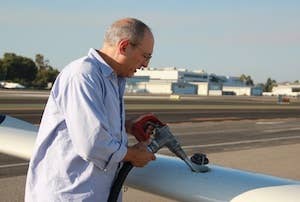
Last week, the FAA issued a report on its plan to replace 100LL with an unleaded alternative. The goal of the new Unleaded Avgas Transition Aviation Rulemaking Committee is to develop a entirely new fuel to replace 100LL. After attending a presentation at Santa Monica's Museum of Flying this weekend, I'm wondering why.
The presentation was held by Lars Hjelmberg, owner of Hjelmco Oil – a company from Sweden that has been producing unleaded aviation fuels for more than three decades. The most widely distributed version, 91/96 UL, has been available since 1991. Since then, millions of flight hours have been flown in many different types of airplanes using this fuel, according to Hjelmberg. 91/96 UL is available today at more than 70 different airports in Sweden.
In addition to being unleaded, there are other benefits to Hjelmco’s 91/96 UL over 100LL, according to the data presented by Hjelmberg. The emissions released into the air are dramatically lower with this fuel than with 100LL. It is apparently even 35 time more pure than car gas on selected environmental parameters. Hjelmberg also claims that the airplanes that have been using 91/96 UL fuel experience better performance and the engines that normally require a 2,000-hour TBO have been able to reach 3,000 hours. In addition, 91/96 UL is “100 percent mixable with leaded avgas” according to Hjelmberg, so it could conceivably simply be filled directly into the old 100LL tanks. And, unlike 100LL, 91/96 UL can use the same distribution methods as mogas (car fuel), so it’s less expensive to transport.
Cost-wise, the product has been able to compete with 100LL. Hjelmberg claims the cost for the unleaded fuel is generally less because of lower taxes and because of the lack of lead, which has become extremely expensive with only one supplier available. Kristianstads Flygklubb, a flying club in southern Sweden, sells both fuel types for the same price. And if the product would become more accepted in the industry and production rates increased, the cost would likely decrease.
The fuel complies with U.S. standard ASTM 910 (the same as for 100LL) and has been approved specifically by Lycoming (as early as 1995) and Continental for many of its engine models. In May of this year, Cessna released a service letter approving most Cessna 172s and Cessna 177s for the use of Hjelmco 91/96 UL and another European unleaded fuel called UL91 based on ASTM D7547. Unfortunately the service letter only applies to airplanes operated in Europe.
The European Aviation Safety Agency (EASA) has also issued a safety information bulletin, 2010-31, which approves the use of Hjelmco 91/96 UL in “orphaned” airplanes – those whose manufacturers are no longer available to modify the pilot’s operating handbooks – that use fuels that qualify under certain standards, including ASTM 910.
In order to use this fuel, the only requirement for 70 percent of general aviation piston airplanes is to use an oil that contains certain additives, such as Shell’s 15W50, W80Plus or W100Plus, according to Hjelmberg. For an additional 20% of the fleet, mostly light-sport airplanes, the fuel can be used with no special requirements. But for the remaining 10 percent, it’s a little bit more complicated. Turbocharged, higher horsepower engines and “special” airplanes such as warbirds, can’t use the fuel without modifications. But there are solutions out there that would allow these operators to use the 91/96 UL as well. Unfortunately these modifications would be quite costly, but if the FAA is going to spend years and millions of dollars, why not take that money and give it to these airplane owners instead? The money could also go to new fuel stations, in which case there could be a transition period when both 100LL and unleaded fuels are available.
In addition to the issues that apply to about 10 percent of the GA fleet, there is one thing that concerns me as a user. Because Swedish law requires that no dyes are added to unleaded fuels, the 91/96UL is clear, so there is no way for the pilot to verify that the correct fuel type exists in the tanks. This should, however, be an easy problem to solve by adding some dye, though it may take several years and piles of paperwork to get such a modification through the authorities.
I don’t know much about the politics of fuel, but with the decades of testing and the approvals that have gone through EASA, I don’t see why the FAA couldn’t approve this fuel for use in the U.S. If the benefits that Hjelmberg claims are true I would think that most airplane owners would be happy to use this fuel. According to Hjelmberg, there are four avgas producers in Europe, three of which offer unleaded fuel. Hundreds of airports in Europe already have unleaded fuels available. If we’re going to transition to unleaded, why reinvent the wheel?
We welcome your comments on flyingmag.com. In order to maintain a respectful environment, we ask that all comments be on-topic, respectful and spam-free. All comments that do not comply with these guidelines will be removed.

Sign-up for newsletters & special offers!
Get the latest FLYING stories & special offers delivered directly to your inbox






